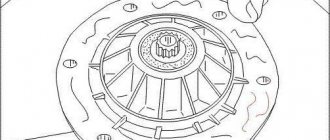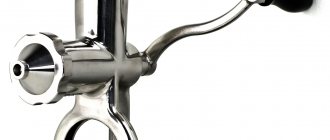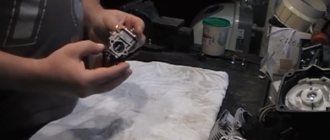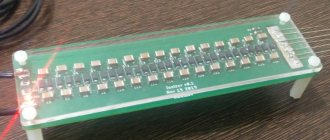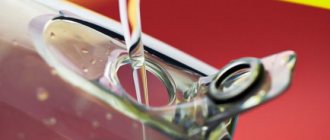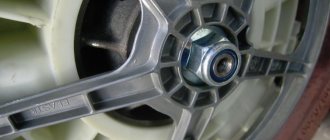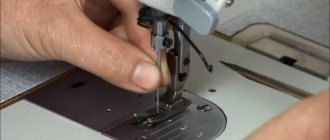- home
- Miscellaneous
>
⬎
Currently, Soviet-made washing machines are still gathering dust in many closets and garages. And when the time finally comes to throw away the machine, its electric motor, and perhaps even two, come to attention. After all, most often the motor is working and you can make homemade emery out of it. Well, the sharpener is a quite useful thing and will be useful to any master. Our publication is devoted to creating a small, low-power sharpening machine with your own hands from the engine of a Sovdepov-made washing machine.
Why exactly from a machine made in the USSR? Firstly, the motor in such machines is brushless, asynchronous, unlike modern washing machines, which usually have brush motors. Brushes are extra wires when connecting, there is a high probability of needing to replace them. Secondly, the shaft on new motors often has a complex attachment to the pulley, and this complicates adaptation to the grindstone. And thirdly, it’s easier to get an old engine, the issue is of course controversial, but I think many will agree.
I don’t insist at all that the electric motor must be from a washing machine; if you have any other one with a power of at least 180 W, you can use that for our sandpaper.
What determines the choice of motor?
First of all, it should be explained why, in most cases, a motor from a washing machine is used in the manufacture of a sharpener. The fact is that old models, such as Volga, Chaika, Ural and many others, had ideal speeds for sanding, 1000 - 1500 per minute. It was this frequency that allowed their activator to spin at optimal speed. At the same time, washing machines varied quite significantly in maximum load, and therefore in engine power. In most cases it ranged from 200 to 400 watts. This is quite enough so that even axes can be sharpened with sandpaper.
However, before you start manufacturing, you must definitely study the “nameplate” on the engine body. This is a tin plate on which the main parameters of the motor are indicated. It is important that the shaft rotation speed does not exceed 3000 rpm. This is due to the fact that the grinding wheel is not designed for high angular speed and, if the maximum value is exceeded, it may collapse. This is very dangerous, especially considering that most homemade sandpapers lack protection. Moreover, a high rotation speed will lead to overheating of the sharpened tool, and hence to loss of cutting qualities.
In addition to optimal frequency and power, the washing machine motor has a number of significant advantages:
- Connection to the electrical network without additional modifications.
- The existing mounts make it easy to mount the engine to the sandpaper base.
- The length of the motor shaft allows you to place a sharpening stone on it, albeit with the help of an adapter.
Now that the choice of motor for the emery is justified, we can move on to the process of its manufacture.
Emery from a washing machine motor
What's good about Soviet washing machines is that they were equipped with reliable electric motors. Another advantage of using such motors for a sharpener is the low power and shaft speed, and this is important for an emery grinding wheel, which at high speeds can simply crack upon contact with the tool being processed. Good weight and power supply from a 220 V network are also convenient: in the first case, the emery will be stable without the use of additional attachments, the second indicator saves the master from the need to assemble the starting unit for the emery: it can simply be taken from the washing machine.
Sandpaper from a washing machine engine is in no way inferior to factory models. And if in the case of Chinese technology one can still doubt the longevity of the product, then a homemade design, where every detail has passed through its own hands, will indeed be an indispensable assistant for many years.
What you need
To make emery with your own hands, you will need certain tools and materials. The simplest design eliminates the need for welding and turning, which allows it to be manufactured by almost anyone. Set of necessary tools:
- a jigsaw or a regular wood hacksaw (it’s better if the hacksaw is a packaging one);
- electric drill with a set of drills;
- screwdriver or shaped screwdriver;
- Angle Grinder;
- soldering iron 100 W;
- small chisel;
- a square with one of the angles at 90 degrees;
- calipers;
- drawing compass;
- drawing pencil and tape measure;
- metal scissors;
- bench vise;
- a piece of 150 grit sandpaper.
Set of necessary materials and equipment:
- model of a Soviet electric motor from a washing machine with capacitors;
- toggle switch for loads up to 1.0 kW;
- cord with socket 2 meters long;
- small sharpening stone with a mounting hole diameter of 32 mm;
- chipboard slab measuring 0.5x0.5 meters and thickness 0.02 meters;
- multilayer plywood measuring 0.15x0.15 meters and thickness 0.01 meters;
- timber measuring 60x60 mm and height 0.2 meters;
- wood screws 50 and 20 mm with a press washer;
- galvanized sheet 0.5x0.5 meters in size and 1 mm thick;
- rubber stoppers for antibiotics in the amount of 4 pcs.
You should not take an electric motor from an automatic washing machine if it is high-speed. The revolutions of the emery should not exceed 1500 per minute, otherwise it will be dangerous to work on such a machine.
Which engine to choose
As mentioned above, the parameters of the washing machine motor must meet certain criteria. Taking the first engine you come across and building an emery structure around it is not very practical if in the end it turns out that it will be impossible to work on such a machine. Therefore, craftsmen with practical experience recommend proceeding from the following points when choosing an engine for making emery with your own hands:
- the most common models among Soviet engines that are used to make emery are the motors of such washing machines as “Malyutka”, “Sibir”, “Volga” or “Vyatka”;
- the recommended engine shaft rotation limit is 1500 rpm;
- It is advisable to take the power no lower than 100 Watts and no higher than 1000 Watts, the most famous motors have a power within 400 Watts;
- if the engine has support legs with holes for fasteners, this is welcome;
- The engine of the future emery must be designed for a voltage of 220 Volts.
Read also: Machine for the production of paper clips
When removing the engine from the washing machine, it is important to remove the entire starting circuit along with it, so as not to separately select and buy capacitors for the emery. If the engine does not have support legs, this will not prevent it from being installed in the structure. It is important here that it has studs, by means of which the body of the unit is tightened: by attaching it to these studs, the motor will be installed on the emery.
How and from what to make security elements
The protective casing in the emery is an extremely important design element. It serves as a protection against possible injuries when the grindstone breaks, and also prevents sparks from getting into the eyes and onto nearby objects. Also, if you take motors from washing machines, then in some of them the stator winding may be open and it must be protected from abrasive and other foreign particles. It is impossible to seal the engine housing, as this disrupts the cooling mode of the unit and it may fail. In this case, the protective casing also plays an important role, simultaneously protecting the emery motor.
The most convenient way to make a protective casing with your own hands is to make it from galvanized steel. It is not necessary to make it round, following the contours of the working grinding wheel; it is easier to make it in the form of a truncated cone, where the upper part is slightly larger in size than the diameter of the stone. The easiest way to attach such a casing is not to the engine, but directly to the emery support on which the motor is mounted.
According to the rules, the casing must cover the working tool on all sides, leaving open only a small window in the working area, namely part of the end and side planes of the emery circle.
Adapter
This is the only detail that cannot be made by hand. You will need a lathe and, accordingly, a person who knows how to work on it. What is the adapter for? The fact is that the size of the motor shaft is about 14mm, while the mounting hole
The emery circle usually has a diameter of 32 mm. This means that their “direct” connection is absolutely excluded. The adapter seems to increase the washing machine motor shaft to the required size.
To make it, you will need a piece of round steel, approximately 65 mm long. and diameter 60 mm. The last figure is due to the need for the so-called flange - a fixed washer on the body of the part, into which a circle of emery rests on one side. Its thickness must be at least 4 mm. A seat with a diameter of 32 mm is machined in front of the flange. Next comes the “M20” thread, onto which the nut that secures the circle will be screwed.
For mounting on the engine, a hole is made in the adapter body with a diameter equal to the shaft. Then everything depends on how the pulley was fixed on the washing machine. There were two main options:
- Using a thread on the motor shaft and a large nut.
- Bolt 4, screwed into the adapter body, perpendicular to the longitudinal axis of the motor.
The part being manufactured must have one of the following mounting methods, depending on the type of engine.
Sometimes, home craftsmen try to minimize costs and make an adapter with a flange themselves. Most often, a pipe with suitable internal and external diameters is used as a base. You shouldn't do this without proper experience. The fact is that it is very difficult to select a suitable workpiece, so “beats” and distortions are inevitable. It will be unsafe to work with such emery. You should not save on your health, especially since the cost of a master’s work will not exceed 500 rubles, and if the part is made from its own material, it will cost even less.
Another adapter diagram for making emery from a washing machine engine
What is sandpaper used for?
An emery machine is useful for the following work:
- Restoring the cutting qualities of the drill. To avoid buying new drills, you need to know how to sharpen old ones. When working with a drill, the drill gets very hot, which is why it constantly becomes dull. Once you sharpen it on a machine, you can use it many more times.
- Sharpening knives, scissors, shovels and other tools. Thanks to a homemade machine made from a washing engine, your knives will always be sharp and your scissors will cut perfectly. You don't need to use any special effort for this.
- If you replace the emery wheel with a polishing wheel, you can easily process products and parts.
Using the motor from the washing machine, you can make a sharpening machine with your own hands. To do this, you will have to buy just one part - an emery wheel. All other components are located in the motor.
Base
The frame on which the engine will be mounted does not require any special material costs, but this does not make it any less significant. The base must be well thought out, since making emery is not an end in itself; you still have to work on it. At the same time, all attention should be focused on sharpening the tool, and not on holding the motor jumping all over the workbench with your hand. Working like this is, at the very least, inconvenient, and in this case there is no talk of compliance with safety regulations at all.
Therefore, the base of the emery should be heavy enough, and most importantly, allow the motor to be fixed in the same way as it was fixed to the washing machine. It is best, of course, to make the frame metal. True, you will have to use welding for this. If this is not possible, then you should take a suitable piece of chipboard and bolt metal corners onto it to mount the engine. Even better, remove the motor from the washing machine along with the standard bracket and screw it to the base. The main thing is to use bolts and nuts for this; self-tapping screws can become loose and unscrew due to vibration.
There is one more key point. The height of the motor mounting should not only allow the emery wheel to rotate freely, but also provide a gap of 4 - 5 cm between it and the base. After the motor is securely mounted on the frame, you need to think about the support table. It must be metal; welding can be replaced with a bolted connection. If the starting capacitor on the washing machine was moved outside the motor housing, you need to provide a place for it on the base of the sandpaper.
Once the motor is securely fastened to the frame and all auxiliary elements are installed, you can proceed to the electrical connections. But first you need to make sure that the grinding wheel is securely fastened to the motor shaft, as well as that there are no various beats.
Device assembly and safety precautions
After assembling the device structure, you need to install the device on the workbench. This can be done using a bracket from a washing machine. It needs to be attached to the workbench using bolts.
On the other hand, the engine rests on an angle to support it horizontally. This corner has a special cutout that matches the shape of the engine.
You can reduce the vibration of the device during operation. To do this, you need to put a special edging on the corner, made from a piece of rubber hose.
Read also: Tailstock 1k62 drawing
To comply with safety precautions during sharpening, it is necessary to make a metal casing for the device. It is made from sheet metal 2-2.5 mm thick. To do this, you need to cut a strip of metal and roll it into a half ring.
Under the abrasive stone, you need to install a piece of galvanized sheet metal, which will protect the workbench from sparks while the machine is operating.
Work on sharpening tools on homemade sandpaper must be carried out wearing safety glasses and observing all necessary safety measures.
You can make special devices for the sharpener. You need to prepare plexiglass with a thickness of 5 mm. Attach it with hooks to the motor casing. This glass should tilt 180°.
To make the work easier, you need to make a tool rest. It is necessary to support the tool being processed.
If you follow these instructions, you can make your own electric emery that will successfully process the necessary tools and will last a very long time. When operating the device, be sure to follow safety precautions.
Many business people wouldn't mind having a functional sharpening machine on hand. Equipment of this type from a good manufacturer is not cheap. It is not at all necessary to spend money on buying a new machine, since it is quite possible to make emery with your own hands, spending a minimum of money and effort.
Among the many power tools needed in the household, emery takes pride of place in demand. It will be useful in the garage for sharpening knives, in the country; will be indispensable for any craftsman.
Guided by the photo and video materials in the article, possessing the necessary set of materials and tools, and with minimal skills, you can easily make homemade emery. The design of the future machine will include: an emery stone (sharpener), a support frame, an auxiliary table, and electrical equipment.
